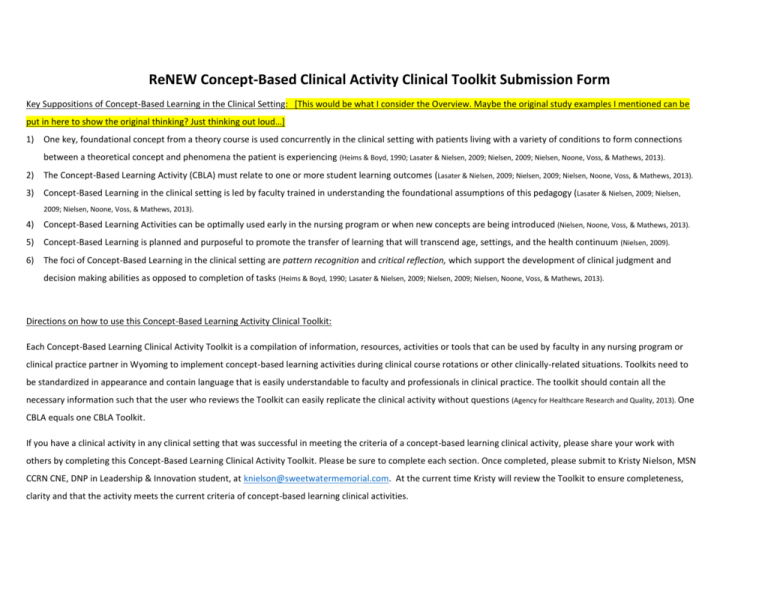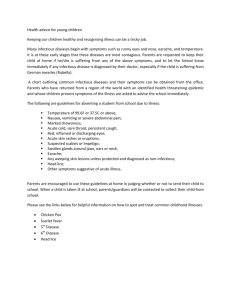Clinical CBL Toolkit Oxygenation chronic and acute filled out
advertisement

ReNEW Concept-Based Clinical Activity Clinical Toolkit Submission Form Key Suppositions of Concept-Based Learning in the Clinical Setting: [This would be what I consider the Overview. Maybe the original study examples I mentioned can be put in here to show the original thinking? Just thinking out loud…] 1) One key, foundational concept from a theory course is used concurrently in the clinical setting with patients living with a variety of conditions to form connections between a theoretical concept and phenomena the patient is experiencing (Heims & Boyd, 1990; Lasater & Nielsen, 2009; Nielsen, 2009; Nielsen, Noone, Voss, & Mathews, 2013). 2) The Concept-Based Learning Activity (CBLA) must relate to one or more student learning outcomes (Lasater & Nielsen, 2009; Nielsen, 2009; Nielsen, Noone, Voss, & Mathews, 2013). 3) Concept-Based Learning in the clinical setting is led by faculty trained in understanding the foundational assumptions of this pedagogy (Lasater & Nielsen, 2009; Nielsen, 2009; Nielsen, Noone, Voss, & Mathews, 2013). 4) Concept-Based Learning Activities can be optimally used early in the nursing program or when new concepts are being introduced (Nielsen, Noone, Voss, & Mathews, 2013). 5) Concept-Based Learning is planned and purposeful to promote the transfer of learning that will transcend age, settings, and the health continuum (Nielsen, 2009). 6) The foci of Concept-Based Learning in the clinical setting are pattern recognition and critical reflection, which support the development of clinical judgment and decision making abilities as opposed to completion of tasks (Heims & Boyd, 1990; Lasater & Nielsen, 2009; Nielsen, 2009; Nielsen, Noone, Voss, & Mathews, 2013). Directions on how to use this Concept-Based Learning Activity Clinical Toolkit: Each Concept-Based Learning Clinical Activity Toolkit is a compilation of information, resources, activities or tools that can be used by faculty in any nursing program or clinical practice partner in Wyoming to implement concept-based learning activities during clinical course rotations or other clinically-related situations. Toolkits need to be standardized in appearance and contain language that is easily understandable to faculty and professionals in clinical practice. The toolkit should contain all the necessary information such that the user who reviews the Toolkit can easily replicate the clinical activity without questions (Agency for Healthcare Research and Quality, 2013). One CBLA equals one CBLA Toolkit. If you have a clinical activity in any clinical setting that was successful in meeting the criteria of a concept-based learning clinical activity, please share your work with others by completing this Concept-Based Learning Clinical Activity Toolkit. Please be sure to complete each section. Once completed, please submit to Kristy Nielson, MSN CCRN CNE, DNP in Leadership & Innovation student, at knielson@sweetwatermemorial.com. At the current time Kristy will review the Toolkit to ensure completeness, clarity and that the activity meets the current criteria of concept-based learning clinical activities. Concept-Based Learning Activity (CBLA) - Clinical Title Oxygenation Submitted by Heidi Brown MS, RN, Associate Professor of Nursing, Western Wyoming Community College, Rock Springs, WY Course Select the theory course that applies to the CBLA: Core Curricular Concept (s) Health Promotion (Semester 2) ☐ Chronic Illness (Semester 3) ☒ Acute Care (Semester 4) ☒ Complex (Semester 5) ☐ Populations (Semester 6) ☐ Leadership (Semester 7) ☐ Select all that apply to the CBLA: Safety ☐ Clinical Judgment ☐ Leadership ☐ Patient Centeredness ☒ Professionalism ☐ Health Promotion ☐ Unit Concepts Select and bold one (1) theoretical concept that is currently being taught in the classroom that matches the CBLA described in this toolkit: Advocacy ☐ Comfort ☐ Grief and Loss ☐ Metabolism ☐ Acid/Base Regulation ☐ Cultural diversity ☐ Mobility ☐ Addiction ☐ Development ☐ Health, Wellness and Illness ☐ Immunity ☐ Perioperative Care ☐ Reproduction ☐ Mood and Affect ☐ Safety ☐ Assessment ☐ Cellular regulation ☐ Ethics ☐ Family ☐ Infection ☐ Inflammation ☐ Nutrition ☐ Oxygenation ☒ Self ☐ Sexuality ☐ Stress and Coping ☐ Teaching/Learning ☐ Thermoregulation ☐ Tissue Integrity ☐ Other ☐ (Please indicate):_________ Cognition ☐ Objectives Specific to the Concept-Based Learning Clinical Activity Fluids and Electrolytes ☐ Intracranial ☐ Regulation Perfusion ☐ Please list: Examine the influence of culture on the clients’ health. State the cultural and age-related considerations for development of lung disease. Discuss the relationship of social and occupational history with pulmonary disease Explore the impact of chronic illness (lung disease) on family members Spirituality ☐ ______________ Challenge assumptions of caring for smokers who develop lung disease. Discuss ways the nurse can help clients and families cope with chronic illness and/or a change in the level of functioning and care. Identify physiological changes of a client with chronic lung disease. Setting Please select all settings in which the CBLA applies: Long-term Care ☒ Acute Care ☒ Public Health ☐ Home Health ☒ Community based – Please describe: ☐ _______________________ Other – please list: Student Learning Outcomes (SLO) Below are the end-of-semester student learning outcomes of ReNEW. Match the clinical activity to all appropriate student learning outcomes of the specific theory course. The core curricular concept appropriate to the student learning outcome is included for your convenience. Acute Illness 1. Examine organizational responsibilities in providing a just culture which values safety. ☐ Complex Illness 1. Examine the relationship between national patient safety resources and error-reporting systems in managing care in the complex patient. ☒ Core Concept: Safety Core Concept: Safety 2. Discover gaps in practice which veer from best practice. ☒ 2. Explore the use of root cause analysis (RCA) to enhance quality care and patient safety. ☒ Core Concept: Safety Core Concept: Safety 3. Use evidence and its role in acute illness care.☐ 3. Use evidence in the care of patients with complex illnesses.☐ Core Concept: Clinical Judgment Core Concept: Clinical Judgment 4. Apply the nursing process for evidence-based plans of care for patients with acute illnesses. ☒ 4. Apply the nursing process for evidence-based plans of care for patients with complex illnesses. ☒ Core Concept: Clinical Judgment Core Concept: Clinical Judgment 5. Use knowledge, theories and concepts from liberal education and the sciences when developing a plan of care for patients with acute illnesses.☒ Core Concept: Clinical Judgment 6. Use organizational skills such as delegation, prioritization and efficient use of resources. ☐ 5. Use knowledge, theories and concepts from liberal education and the sciences when developing a plan of care for patients with complex illnesses.☒ Core Concept: Clinical Judgment 6. Demonstrate leadership abilities and responsibilities based on increased awareness of effectiveness within a variety of healthcare settings to include delegation, supervision, and conflict management. ☐ Core Concept: Leadership Core Concept: Leadership 7. Demonstrate communication techniques to facilitate interprofessional healthcare team effectiveness in the care of the patients with acute illnesses. ☐ 7. Engage other healthcare professionals in the care of patients with complex illnesses. ☐ Core Concept: Leadership 8. Explore the structure of health care organizations, Core Concept: Leadership 8. Explore the structure of health care organizations, healthcare policy and healthcare policy and economics as they apply to acute illness.☐ economics as they apply to complex illness.☐ Core Concept: Leadership Core Concept: Leadership 9. Explore care coordination in providing care for patients with acute illnesses.☐ 9. Participate in care coordination for patients with complex illnesses. ☐ Core Concept: Leadership 10. Demonstrate culturally and developmentally appropriate assessments by focusing on the lived experiences of patients with acute illnesses. ☒ Core Concept: Leadership 10. Analyze the results of culturally and developmentally appropriate health assessments by focusing on the lived experience of the patients with complex illnesses.☒ Core Concept: Patient Centeredness 11. Use caring behaviors to provide safe and effective, developmentally and culturally appropriate care to patients with acute illness.☐ Core Concept: Patient Centeredness 11. Use caring behaviors to provide safe and effective, developmentally and culturally appropriate care to patients with complex illness. ☐ Core Concept: Patient Centeredness 12. Use therapeutic communication skills in the development of therapeutic relationships with patients and families within the context of acute care.☐ Core Concept: Patient Centeredness 12. Use therapeutic communication skills in the development of therapeutic relationships with patients and families within the context of complex illness.☐ Core Concept: Patient Centeredness 13. Apply the role of an effective advocate when participating in the care of patients with acute illnesses. ☐ Core Concept: Patient Centeredness 13. Apply the role of an effective advocate when participating in the care of patients with complex illnesses. ☐ Core Concept: Patient Centeredness 14. Demonstrate principles of accountability, integrity, and autonomy while providing care for patients with acute illnesses. ☐ Core Concept: Patient Centeredness 14. Demonstrate principles of accountability, integrity, and autonomy while providing care for patients with complex illnesses. ☐ Core Concept: Professionalism Core Concept: Professionalism 15. Demonstrate adherence to the scope of practice while providing care for patients with acute illness.☒ 15. Demonstrate adherence to the scope of practice while providing care for patients with complex illness.☒ Core Concept: Professionalism 16. Use evidence to guide health screening, health teaching, and health counseling for individuals and families as it relates to acute illness.☒ Core Concept: Health Promotion Description of Concept-Based Learning Clinical Activity (CBLA) Individual student activity Yes ☒ No ☐ Group activity Yes ☒ No ☐ Core Concept: Professionalism 16. Use evidence to guide health screening, health teaching, and health counseling for individuals and families as it relates to complex illness.☒ Core Concept: Health Promotion 17. Explore the role of the nurse in emergency preparedness of health care settings that provide care for patients with acute illness. ☐ 17. Describe the role of the nurse in emergency preparedness of healthcare settings that provide care for patients with complex illnesses. ☐ Core Concept: Health Promotion Core Concept: Health Promotion Include or embed links to articles, PowerPoints, videos, podcasts, images, documents, and diagrams – any resource(s) used in the activity – such that anyone could easily replicate this CBLA without questions. Gather data pertaining to patient through a variety of sources such as physical assessment, electronic medical record (EMR), labs, health history, and patient interview. •Begin to interpret gathered data related to the core concepts. •Formulate and evaluate nursing interventions that support core concepts and interrelated concepts. •Differentiate between nursing initiated and collaborative interventions. •Recognize and evaluate collaborative interventions that support core concepts and interrelated concepts •Begin to apply knowledge of selected concepts to clinical situations •Begin to recognize the coordination of care with other members of the team •Identify nursing principles of pharmacology and safe medication administration •Familiarize self with technical requirements utilized in the clinical setting •Participate in guided reflection of experience This activity can be instructor led in a health care agency, or instructor or preceptor led in the community (home of a client suffering problems r/t oxygenation). Supplies needed List: Dependent on clinical site. Stethoscope. Preparation time State: Theory on oxygenation and care of the client experiencing oxygenation problems, include assessment, planning, diagnosis, Interventions (including pharmacy) and evaluation. Any respiratory lab experiences should proceed this clinical. Set-up needed Describe: Instructor or clinical coordinator to set up experience at health agency or with preceptors in community. References, if any, in APA format Validation Expert review ☐ Usability testing ☐ Focus groups with users ☐ Pilot testing ☐ Other (please list): ☒ __One of the first submissions of toolkits. May be used for pilot August 5, 2015____ Note: At this time this section will be completed by Kristy Nielson or others assisting in the pilot study. Draft March 11, 2015 ReNEW Clinical Education Committee; May 19, 2015 by ReNEW Consortium; June 20, 2015 Kristy Nielson

